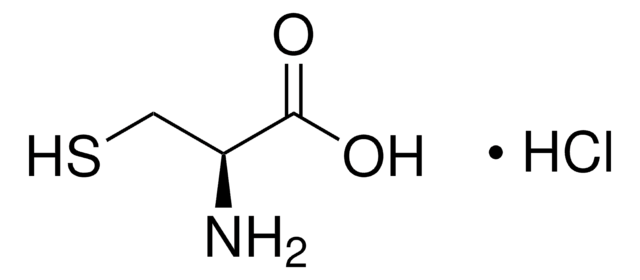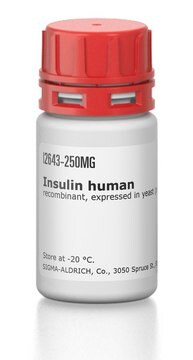V900342
Cysteamin -hydrochlorid
Vetec™, powder or crystals, 98%
Synonym(e):
2-Amino-ethanthiol -hydrochlorid, 2-Mercapto-ethylamin -hydrochlorid, Decarboxycystein -hydrochlorid, Thioethanolamin -hydrochlorid
About This Item
Empfohlene Produkte
product name
Cysteamin -hydrochlorid, Vetec™, reagent grade, 98%
Qualität
reagent grade
Produktlinie
Vetec™
Assay
98%
Form
powder or crystals
mp (Schmelzpunkt)
67-71 °C
Löslichkeit
water: 50 mg/mL, clear, colorless to very faintly yellow
Lagertemp.
2-8°C
SMILES String
Cl[H].NCCS
InChI
1S/C2H7NS.ClH/c3-1-2-4;/h4H,1-3H2;1H
InChIKey
OGMADIBCHLQMIP-UHFFFAOYSA-N
Suchen Sie nach ähnlichen Produkten? Aufrufen Leitfaden zum Produktvergleich
Rechtliche Hinweise
Signalwort
Warning
H-Sätze
Gefahreneinstufungen
Acute Tox. 4 Oral - Eye Irrit. 2 - Skin Sens. 1 - STOT SE 3
Zielorgane
Respiratory system
Lagerklassenschlüssel
11 - Combustible Solids
WGK
WGK 3
Flammpunkt (°F)
Not applicable
Flammpunkt (°C)
Not applicable
Analysenzertifikate (COA)
Suchen Sie nach Analysenzertifikate (COA), indem Sie die Lot-/Chargennummer des Produkts eingeben. Lot- und Chargennummern sind auf dem Produktetikett hinter den Wörtern ‘Lot’ oder ‘Batch’ (Lot oder Charge) zu finden.
Besitzen Sie dieses Produkt bereits?
In der Dokumentenbibliothek finden Sie die Dokumentation zu den Produkten, die Sie kürzlich erworben haben.
Unser Team von Wissenschaftlern verfügt über Erfahrung in allen Forschungsbereichen einschließlich Life Science, Materialwissenschaften, chemischer Synthese, Chromatographie, Analytik und vielen mehr..
Setzen Sie sich mit dem technischen Dienst in Verbindung.





